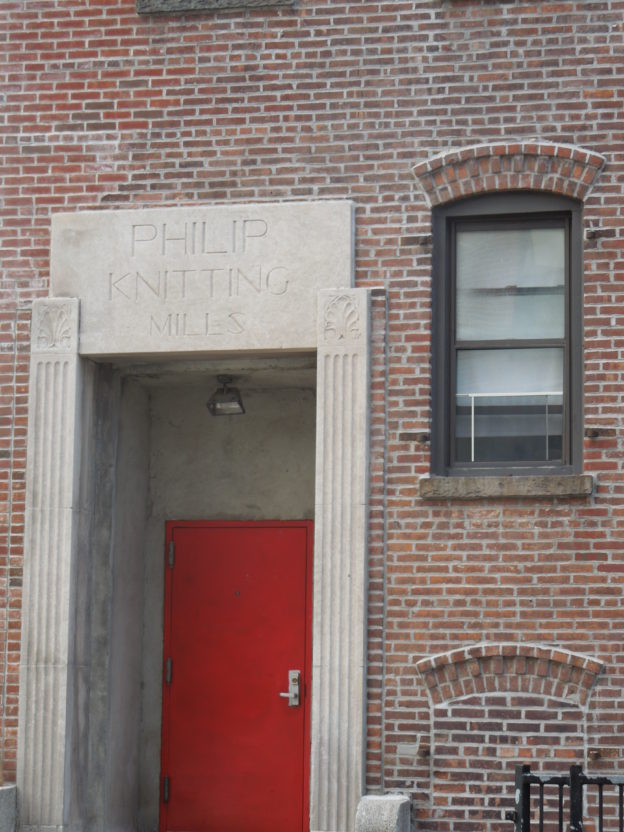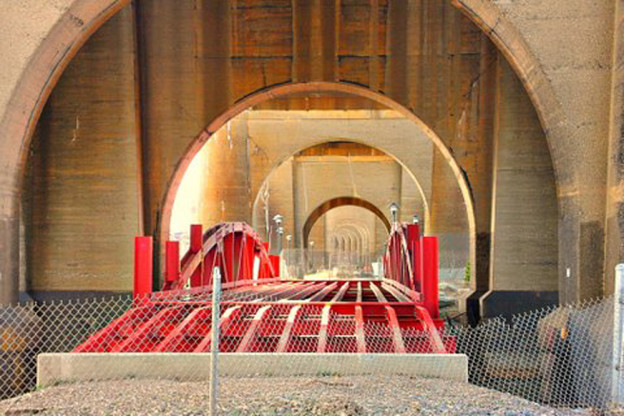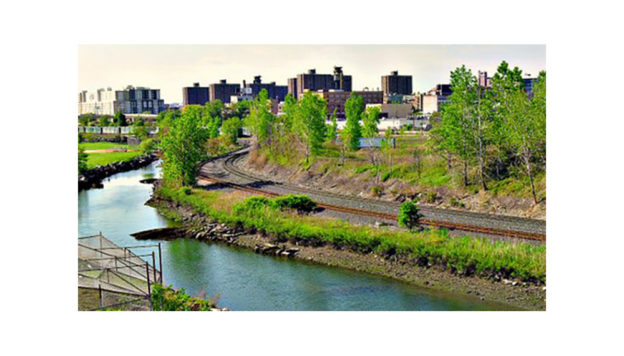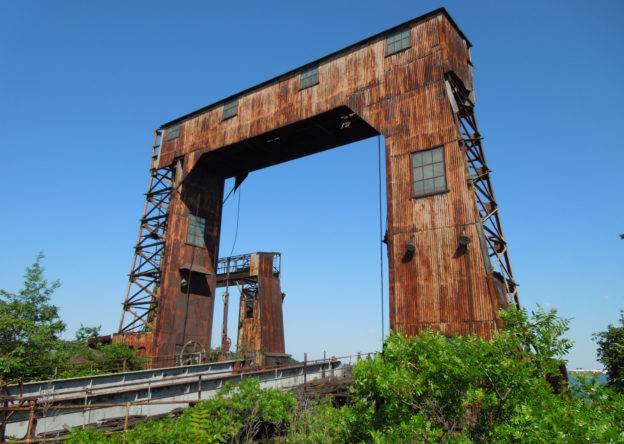Willow Avenue, East 132nd to East 138th Streets;
Ca. 1880–1910|
This captivating six-block stretch contains several historic factory buildings. The Philip Knitting Mills on the southeast corner of Willow and East 136th Street was constructed in 1884 and features decorative brickwork on its cornice and window lintels. Its doorway on East 136th Street was later decorated with art-deco limestone details. Also of note are the two factories on the street’s west side between East 135th and East 136th Streets. At East 136th Street is a factory dating to 1907, whose southern façade is graced with original wood shutters, seen from the alley off Willow Avenue. To the south is the Marcus Brush Company, which features decorative brickwork on its cornice and painted signs on Willow Avenue.
Ca. 1917|
Extending north from East 132nd Street underneath the highway bridge is a series of concrete arches supporting the approach to the Hell Gate Bridge to Randalls Island. This historic railroad bridge is one of the neighborhood’s most notable engineering features.
Adjacent to the ferry bridges site are two General Electric methane gas power plants and an oil tank facility. Local advocates fear that these operations might seek to expand into the ferry bridges site and close up river access points. These include Park Avenue, which has a sizable green space, and Lincoln Avenue, which locals use for fishing and boat launches. For over two decades the South Bronx community has been fighting for environmental justice in the area and has been successful in shutting down the last medical waste incinerator in the city. The fight continues to shut down four polluting power plants on the waterfront. The latest effort is to prevent the food trucking company Fresh Direct from receiving $130 million in public subsidies to occupy the last available stretch of public waterfront within the NYS Department of Transportation–owned Harlem River Rail Yards, located west of the Bruckner Expressway. Numerous actions, demonstrations, community input sessions and door-to-door outreach have garnered the support of dozens of organizations and elected officials, and led to a lawsuit filed by the New York Lawyers for the Public Interest.
106 Locust Avenue;
1948|
The 134th Street Ferry Bridges, or “gantries,” are located on the shoreline of the East River on Locust Avenue between East 134th and East 135th Streets. At roughly four stories tall, they stand as a reminder of New York City’s rich nautical heritage. Prior to the construction of bridges in the early 20th century, passengers and goods were transported by ferry services operating from slips on the waterfront. The 134th Street ferry slip was established in 1902 by the New York and College Point Ferry Company, which had been operating ferries across the East River from various points since 1886. To capitalize on Port Morris’ inclusion in a network of communities serviced by ferry, a market, hotels, restaurants and stables were constructed nearby in 1905.
With the advance of railroad, subway and highway infrastructure, the necessity of ferry service declined and many companies went out of business. The New York and College Point Ferry Company went out of business in 1918, though not entirely due to its obsolescence. George Ehret, Sr., the company’s founder, was understood to have been a financial supporter of German causes and was in Germany at the onset of World War I. As a result of his decision to stay there, the United States government considered him an enemy alien and seized his assets, including the ferry company. From that point, the city controlled ferry operations from the site for transportation to city institutions located on Rikers, Welfare and North Brother Islands. In 1948, North Brother became home to Riverside Emergency Housing for World War II veterans and their families. To accommodate this new island traffic, the city upgraded the 134th Street ferry facility and constructed the ferry bridges that same year. The ferry bridges functioned as gangways to load passengers and vehicles onto the ferry boats and absorb some of the impact of boats entering the slip. In 1966, the ferry was discontinued and the Police Department began using the site as a marina. A one-story brick building was constructed for the Harbor Unit headquarters. Today the site is still owned by the city, but has been mostly unused since the 1990s.
In 2006, the city revealed its proposal for the South Bronx Greenway, which includes a new ferry service connecting recreational hot spots along the waterfront, including a stop at the ferry bridges called the East River Landing. In 2013, construction will begin on a quarter-mile path from East 132nd Street to Randall’s Island called the Randall’s Island Connector. The path will run beneath the arches of the railroad bridge and be equipped with lighting, plantings and a pedestrian bridge over the water. Longer term, the plan includes the creation of a bike lane and plantings along Locust Avenue. In addition to these plans, the Friends of Brook Park are advocating for the creation of a public green space at the ferry bridges site.




